I have seen this topic more than once… Folks comparing the Singer Model 201-2 to the Singer Model 15-91. problem is, for many of the comparisons the information is not complete enough to be useful, or at least the comparison is not “apples to apples”. I thought that I would weigh in and give you a complete side by side comparison and take a close look at these two machines… how they are the same and how they are different. The following comparison might surprise you. Although there isn’t a quiz at the end of this lecture, with regards to my comparison you can draw your own conclusions.
Spoiler alert… Aside from the “potted motor” they both share, there is very little similarity between these machines for comparison! Before I talk about the difference between these two venerable sewing machines, I will simply mention the things that are the same and then I will discuss in greater depth the things that are different… One other note. The pictures captioned for the 15-91 are not all 15-91 machines. I don’t have enough 15-91 pictures to show all of the mechanisms. But, the mechanisms and assemblies in all model 15 machines shown here for comparison are identical to the mechanisms and assemblies in the model 15-91.

Singer Model 201 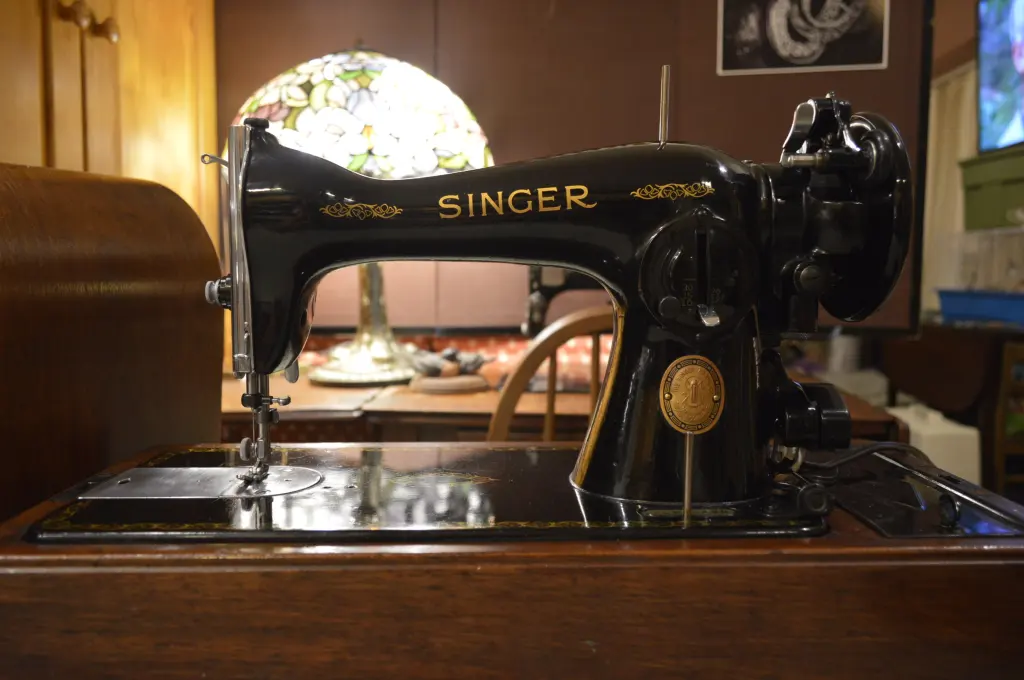
Singer Model 15-91
Similarities:
Both machines have the same footprint area. They have the same hinge distance, and either will fit a Singer cabinet or case. The potted motor is the same on both machines (the bobbin winder assembly attached to the motor is not. The “finger” on the 15-91 is wider to fit the wider class 15 bobbin). The stitch length cover plate and the back access plate are the same. The balance wheel is the same, the bobbin winder guide is the same, the spool pins are the same, the bobbin winder tire is the same, The stop motion knob and washer is the same, the beautiful jet black color is the same, the decals are the same beautiful metallic gold ( but different design), the drop dog feed system is the same, they both use the same standard needle type… and that’s just about it. Aside from the motor, the balance wheel, and these ancillary parts and pieces, all similarities end. To me, they are totally different machines in almost every respect. For a fair comparison, what we need to know is where they differ. Lets take a closer look…
Differences:
First is sewing area. For many folks, especially quilters and those who appreciate a larger harp space, the 201 beats the 15-91 by a small margin. The 201 needle to column distance is 8″, the arm height is 5.5″, and the harp space is 44 sq.inch. The 15-91 needle to column distance is 7″, the arm height is 5″, and the harp space is 35 sq.in. For some folks, these dimensions are important. Does this matter for your sewing projects?
The next is the bobbin style. The 201 uses a horizontal full rotary hook and drop in class 66 bobbin. A full rotary bobbin spins in a 360 degree circle. The 15-91 uses an oscillating hook and a vertical side loading class 15 bobbin. An oscillating hook rocks back and forth in less than half of a 360 degree circle. The class 15 bobbin holds more thread than a class 66 bobbin and requires fewer bobbin changes for large projects… a quilt for example.

Singer 201 horizontal class 66 bobbin case 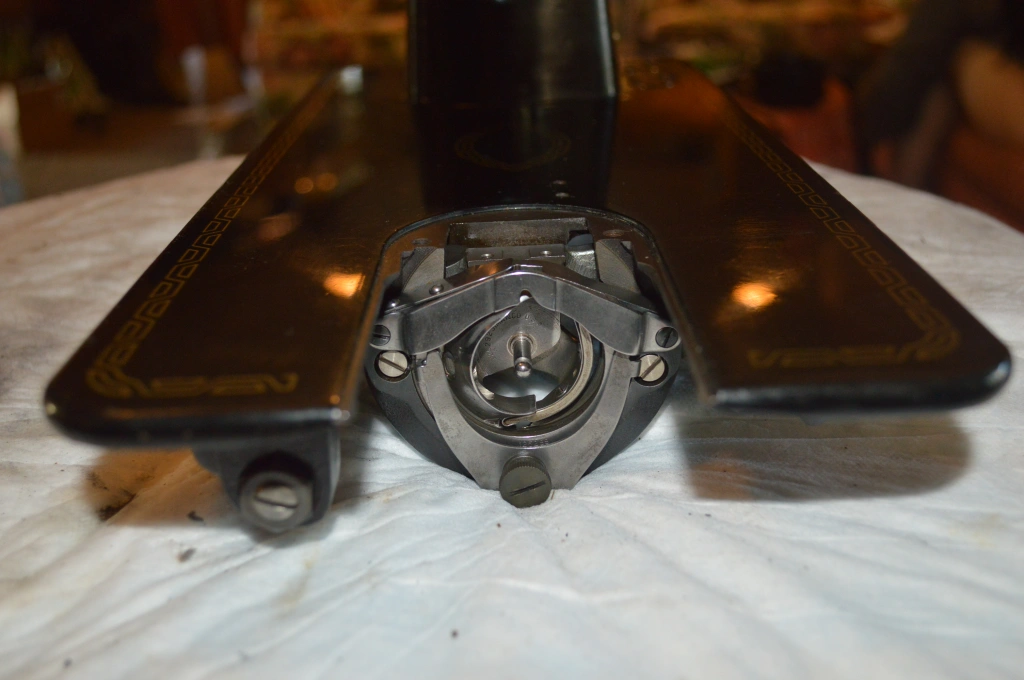
Singer 15-91 vertical class 15 bobbin Case
Drive mechanism:
The 201 drive mechanism is fully gear driven, except for the feed dog rocker assembly. The upper arm shaft is straight and has two eccentric cams attached to it. One cam turns a connecting rod to power the feed dog rocker mechanism. The other drives the stitch length fork. The machine has six matched heat treated steel gears to transmit power thru the top sewing arm shaft. One gear in the arm shaft transmits power to a gear on each end of a vertical shaft in the sewing machine column, and then to two gears on the bobbin drive shaft under the bed of the sewing machine, and then to one gear on the rotary hook shaft. Because of this rotary motion, the 201 runs with very little vibration.
In contrast, The 15-91’s sewing arm is actually a crankshaft with one eccentric cam attached to it. The eccentric cam drives the stitch length fork. The crank turns a connecting rod, the end of which attaches to an eccentric rocker arm and the bobbin drive shaft. This rocker arm drives the bobbin shaft around to a point, and then changes direction to drive the bobbin shaft to a point in the opposite direction (hence the term oscillating hook). It is also connected to the feed dog drive rocker mechanism. Although the drive mechanism on the 15-91 is well balanced, this oscillating movement induces vibration in the machine. One advantage of this system is that the bobbin hook is fixed in position by a pin through the shaft and unless damaged, the hook timing will always be correct.
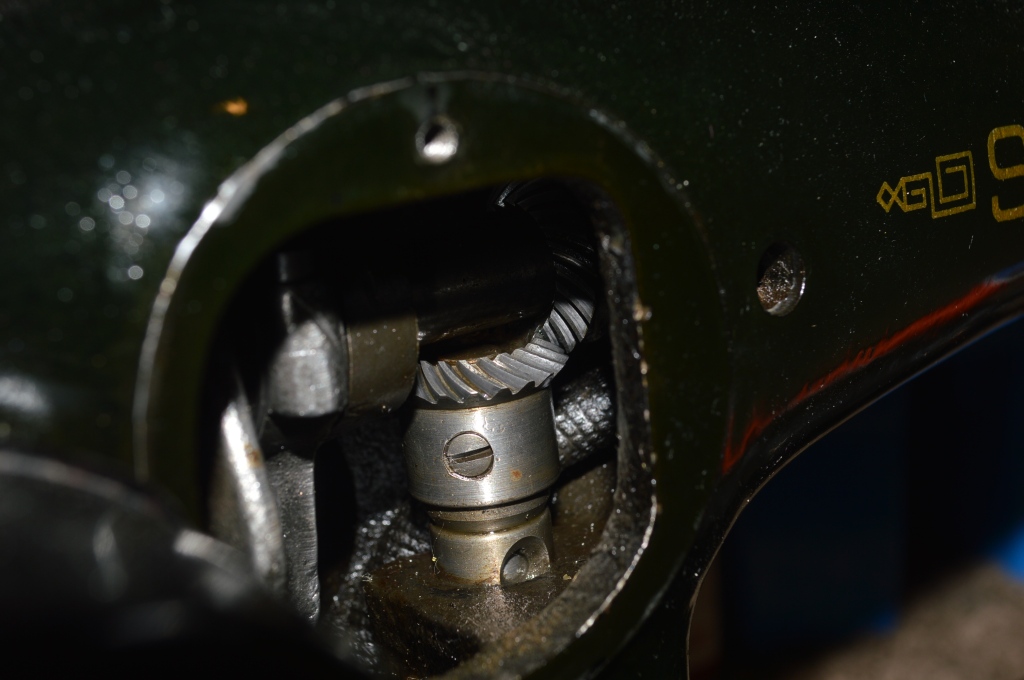
201 top gears 
Bobbin shaft gear 
201 bottom gear train 
201 rotary hook gears 
15-91 top crank 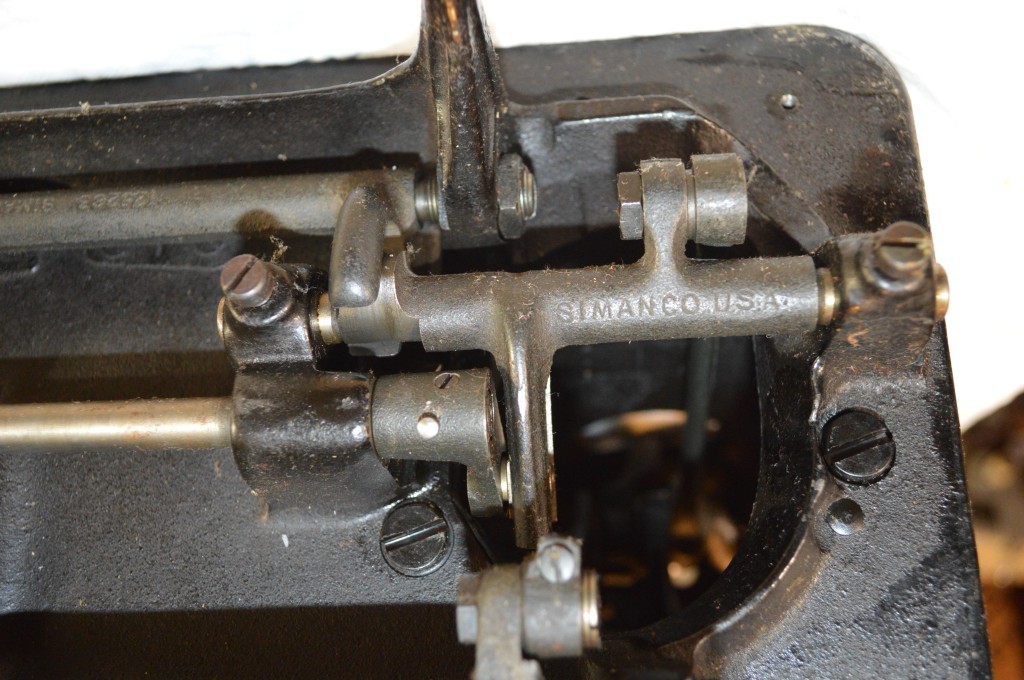
15-91 Bobbin rocker shaft 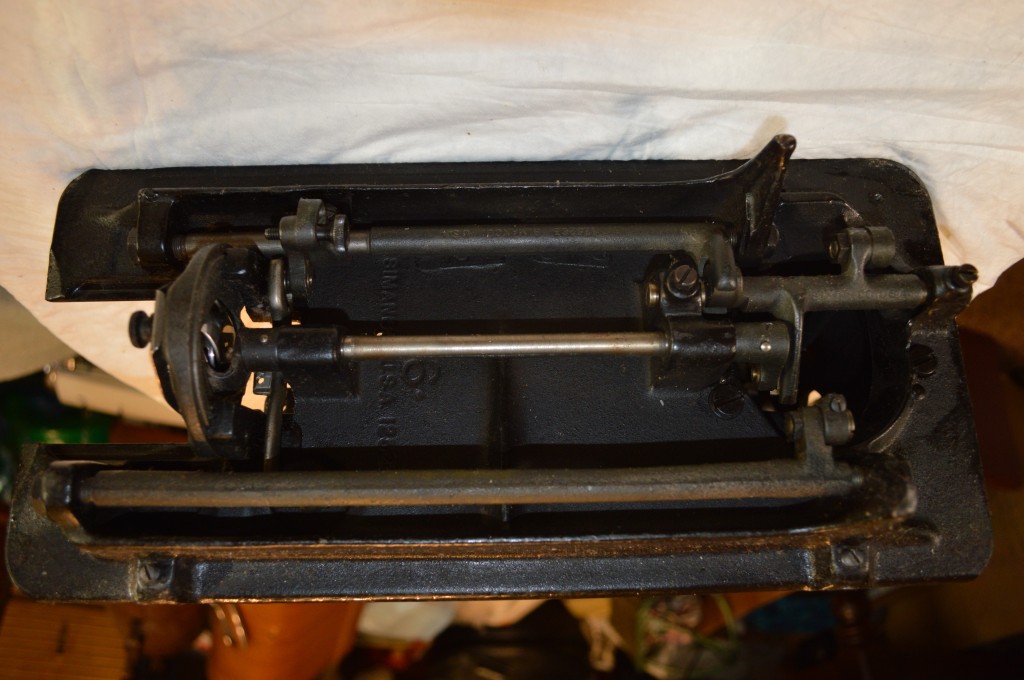
15-91 Bobbin drive system 
15=91 Bobbin hook shaft
In the front of the sewing machine head in the 201, the end of the arm shaft has an eccentric cam crank that turns a three point linkage attached to the needle bar and the take up arm. The top sewing arm on the 15-91 drives the take up arm directly. The take up arm on the 15-91 has a roller bearing that fits in the thread take up cam. This cam has a groove milled into it such that as the cam turns, the roller bearing on the take up arm follows the groove and produces an up and down motion. The needle bar is operated via a connecting link. One end is pinned to an eccentric stud fixed in the thread take up cam.

201 eccentric cam crank 
201 three point needle bar linkage 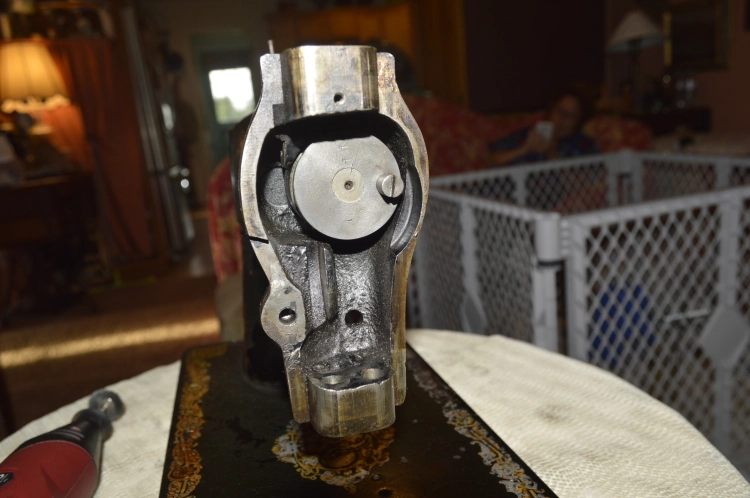
15-91 thread take up cam 
15-91 needle bar linkage
Tension assembly… The 201 tension assembly is located on the front side of the machine. The 15-91 tension control assembly is located on the front end cover plate. The tension controls use the same tension discs and beehive spring, but the take up spring is different. The 201 tension assembly is a separate unit that fits into the machine. On the 15-91, it is integrated in the cover plate.
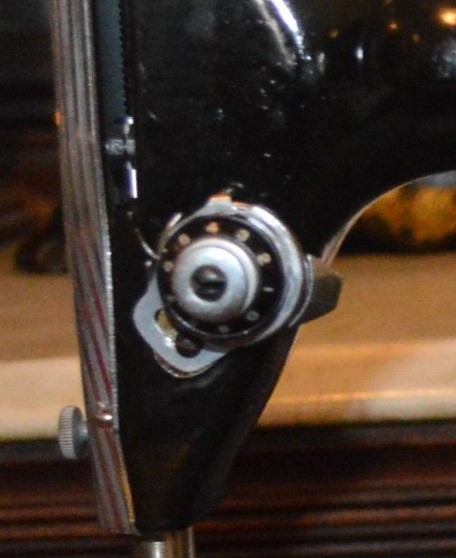
201 tension control assembly 
15-91 tension control assembly
Thread take up arm… The 201’s thread take up arm is on the side of the machine, the 15-91’s take up arm is on the front of the machine.
The light fixture shroud on the 201 is integrated into the body on the front of the machine. On the 15-91, The light fixture is separate from the machine and is located on the back of the machine.
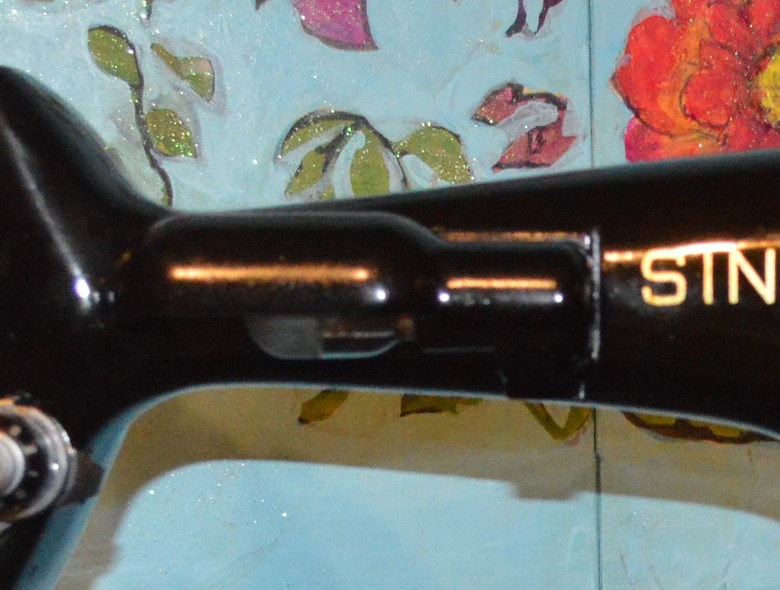
201 light fixture 
15-91 light fixture
Weight… both machines are constructed of cast iron (late production 201’s were cast aluminum). The 201 weighs approximately 34 pounds and the 15-91 weighs approximately 26 pounds. While more weight (mass) helps dampen vibration, I do not think the difference is appreciable in operation of either machine when mounted in a cabinet. This leads to portability… Both are full size and neither is lightweight. Although both will fit in a full size portable case, they are best suited for a cabinet. The 201 will sew on a table top without a base, the 15-91 will not… it needs to be supported in a base.
Class… both are definitely domestic grade machines. neither is commercial grade or industrial strength. However, the 201 does have a class distinction. It is known as a “professional grade” machine. It was designed for a tailors or seamstress use and intended to be used for prolonged periods. One variation of the 201, the identical model 1200 has a knee operated presser bar lift to further highlight its purpose. While this distinction does not raise it to commercial grade, it is recognized to set it apart from others in the domestic arena. The 15-91 has no similar distinction or feature. Does this mean the 15-91 won’t stand up under similar usage? I think not, from my view they are both remarkable and tough sewing machines. Even considering a 70 year old vintage of either, you will not live long enough to wear either of these machines out. Both are heirloom quality and should be passed down through family generations.
So there is the comparison. Which is better? I won’t say and leave it to you to decide. will say that for smoothness, the 201 wins the day. For looks, I love the curves of the 15-91. For stitch quality, both create laser straight balanced stitches. Some say the 15-91 is better for quilting because of the vertical bobbin… I’m not convinced. Some say “what is so special about the 201”?… I say “sew with one and you will know”.
Which would I recommend? That’s easy… the 201… no, wait, the 15-91… uh, the 201… or the 15-91. My point is that as different as they are in comparison, you can’t go wrong or be disappointed with either.
If you like what you see, or looking for a fine restored vintage sewing machine, please visit our Etsy store at https://www.etsy.com/shop/pungoliving, and see all of our other restored fine quality vintage sewing machines. Don’t see what you are looking for? We take custom orders! If you have any questions, please contact Lee at Pungoliving@gmail.com.

Thanks – this is a great comparison! Which do you prefer – peaches or bananas? 😉 But as different as they are, people still have their preferences, usually without a good reason. “I just like the feel of it!” 🙂 I find myself liking the feel of the oscillator better because I like its rhythm, so I prefer 66 over 201 😮 (that’s more comparable). But then again, I like Wheeler & Wilson’s D9 which is a rotary… Go figure! 🙂
LikeLike
Thanks! I picked up an early Singer 9W but I have not decided what to do with it yet… I agree with you completely! My philosophy is use the machine that suits your preference… my Wife enjoys her Singer 27. What a beautiful stitch!
LikeLike
I am partial to vibrating shuttle machines myself. It’s that rhythm again.
LikeLike
Thanks for this in-depth and easy to understand compassion. I have read many posts on the differences and after reading them still could not be certain which machine I have. I’m sure now they are 15-91s. Most posts differentiate with the white “switch” in the front of the machine which is suppose to indicate the machine is a 201.
Your comparison was much clearer.
Thanks for sharing your extensive knowledge. I’m finding myself binge reading most of your posts.
LikeLike
Hello Cam,
Thanks for letting me know you found my blog useful! As you found out, there is much more difference than a white light switch. They are both fine machines!
Have a blessed night and I hope you find my other blogs useful.
Lee
LikeLike
Thank you for this in depth discussion of the difference between the two different models of singer machines. I was just given a 15-91 from 1952 by a coworker, who was cleaning out a relative’s house, and knew I loved the vintage and older sewing machines, but I didn’t know much about it.
I had thought I wanted a 201, eventually, if one became available around where I live, but I’m pretty thrilled with my new gift of the 15-91!
LikeLike
Hello Amy,
The 15-91 is a fine machine. Overall, I would say that the 201 is a little quieter and smoother because it is a gear driven rotary hook, but the difference is a quibble. The 15-91 will make a beautiful straight stitch every bit as nice as a 201 and many folks prefer them for quilting. I would bet you will not find a negative review for either machine.
Take a good look at the wires on your potted motor…. these are the Achilles heel for either machine.
Clean it, oil it regularly, and use it… these machines run better the more they are used.
Thanks for letting me know you found the blog useful and please let me know if I can be of any assistance in answering any questions you may have with your “new” machine.
Have a blessed evening,
Lee
LikeLike
Both great machines. The 15-91 is a bit loud, clanking away.
LikeLike
Hello Andrew,
I completely agree. They are both great machines and it really comes down to preference. The 15 is a bit louder with a bit more vibration, but it is still a pleasant machine to sew with. A drop of oil on the bobbin race and at each of the oiling points goes a long way to quieting any clanking noise. That’s pretty much the same for any oscillating hook machine.
Thanks for your comment!
Lee
LikeLike
Nice to have all this info. I sew on a 201 model, but I did just inherit a 15 model…..wasn’t sure which one to keep and which one to share with my daughter. Think I’ll keep my 201!
I have zero attachments for my 201. The 15 from my mom came with a buttonholer, a gathering foot, etc. Are these items interchangeable between the two models?
Thanks!
LikeLike
Hello Beth,
Why not keep both?
LikeLiked by 1 person
I sew on a model 201 and recently inherited a model 15. The model 15 came with attachments that I do not have — a buttonholer, lots of different feet, etc. Will these items work on both model machines?
Thanks for ALL the info above — I think I’ll keep my 201!
LikeLike
Hello Beth,
Any attachment that will work on a model 15 will work on your 201.
It’s nice to have a good selection of attachments!
Have a wonderful evening!
Lee
LikeLiked by 1 person
Lee
You are a gentleman & a scholar. Your insight as an engineer sheds light on the mechanics of these antique beauties, which continue to sew. A testament to another time and ethos.
I’m an orthopedic surgeon by profession. I always had a liking to anything mechanical and old singers were always around , parents and grandparents .
Of course, the debate about vintage Singers is never ending and that is a part of its appeal to old and new generations of sewers. The Covid crisis helped “revive “ the interest in seeing , maybe one of the few silver linings in such a difficult experience.
I’ve become a collector of vintage sewing machines : The Singer 128 Spinx, 66 Lotus , 201 potted & outboard , 15k & 15K110 , Featherweight , Singer 216G, Singer 316G, Elna Grasshopper , Helvetia free arm, Necchi BU , Necchi Lycia . Some were inherited, bought or gifts. In the future I too, will find proper homes for them.
Which is my favorite? I can play the devil’s advocate for nearly each model. But to round it down, I’d make two categories , Straight stitch and Zig Zag. For the Straight stitch I would say the Singer 201 outboard & Singer 15K110 , for ZigZag : Singer 316G & Necchi BU. But who am I to talk , My grandmother in a remote fishing village in southern Crete , sewed clothes for her family on a Singer 128 handcrank during the Great Depression and WW ll , everything from heavy canvas to fine silk from the German paratroopers, to make dresses for her girls.
LikeLike
Hello Harry,
I’m glad to hear you have gained some insight and experience with many different models of vintage sewing machines.
For straight stitch I give my vote to the 201… I will say that for straight stitch quality, a vibrating shuttle model 27 will give any machine a stitch to compare… and don’t forget, your grandmoter’s model 128 is a shuttle machine.
For zig zag I would put the older vintage White’s at the top of my list. They have a very well regulated feed and will make a beautiful satin stitch… I always compare machines by the zig zag stitch they make.
I have a Necchi BU Mira and it is a fine machine but it is difficult to work on and parts are hard to find. I have not tried an Elna, but Pfaff makes a very solid machine.
It’s great to compare preferences and I appreciate your thoughts!
Lee
LikeLike